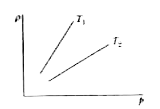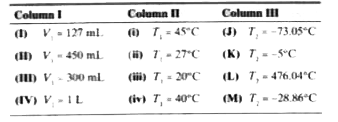PRACTICE QUESTIONS from RESNICK AND HALLIDAY PHYSICS (HINGLISH) THE KINETIC THEORY OF GASES for Class 12
| Class 12 | PHYSICS |
| Chapter | THE KINETIC THEORY OF GASES |
| RESNICK AND HALLIDAY PHYSICS (HINGLISH) | PRACTICE QUESTIONS |
| Medium | English |
| Academic Year | 2023-2024 |
Question 37
The speeds of 25 molecules are distributed as follows: 5 in the range from 2 to 3 m/s, 10 in the range from 3 to 4 m/s, 5 in the range from 4 to 5 m/s, 3 in the range from 5 to 6 m/s, 1 in the range from 6 to 7 m/s, and 1 in the range from 7 to 8 m/s. Their average speed is about View SolutionQuestion 48
A frictionless gas-filled cylinder is fitted with a movable piston, as shown in the figure. The block resting on the top of the piston determines the constant pressure that the gas has. The height his 0.120 m when the temperature is 273 K and increases as the temperature increases. What is the value of h when the temperature reaches 318 K?
 View Solution
View SolutionQuestion 50
A primitive diving bell consists of a cylindrical tank with one end open and one end closed. The tank is lowered into a freshwater lake, open end downward. Water rises into the tank, compressing the trapped air, whose temperature remains constant during the descent. The tank is brought to a halt when the distance between the surface of the water in the tank and the surface of the lake is 40.0 m. Atmospheric pressure at the surface of the lake is 1.01×105 Pa. Find the fraction of the tank's volume that is filled with air. View SolutionQuestion 60
A vessel contains an ideal gas at 27∘C and pressure 200 kPa. The volume of the gas is 8.0 L. The molecules of the gas collide with the walls of the vessel and exert a pressure. The gas is allowed to leak till the pressure falls to 150 kPa and the temperature remains the same. The diameter of the ideal gas molecule is 300 pm. The average distance traveled by the molecule between collisions is termed as the mean free path. The mean free path of a gas molecule varies directly proportional to the temperature and inversely proportional to the pressure. Take, R = 8.3 J/mol K and NA=6.02×1023/mol.
The number of moles of the gas in the vessel before the gas was leaked isView SolutionQuestion 61
A vessel contains an ideal gas at 27∘C and pressure 200 kPa. The volume of the gas is 8.0 L. The molecules of the gas collide with the walls of the vessel and exert a pressure. The gas is allowed to leak till the pressure falls to 150 kPa and the temperature remains the same. The diameter of the ideal gas molecule is 300 pm. The average distance traveled by the molecule between collisions is termed as the mean free path. The mean free path of a gas molecule varies directly proportional to the temperature and inversely proportional to the pressure. Take, R = 8.3 J/mol K and NA=6.02×1023/mol.
The amount of gas leaked is View SolutionQuestion 62
A vessel contains an ideal gas at 27∘C and pressure 200 kPa. The volume of the gas is 8.0 L. The molecules of the gas collide with the walls of the vessel and exert a pressure. The gas is allowed to leak till the pressure falls to 150 kPa and the temperature remains the same. The diameter of the ideal gas molecule is 300 pm. The average distance traveled by the molecule between collisions is termed as the mean free path. The mean free path of a gas molecule varies directly proportional to the temperature and inversely proportional to the pressure. Take, R = 8.3 J/mol K and NA=6.02×1023/mol.
the average translation kinetic energy of the molecules of the gas is View SolutionQuestion 63
X and Y are two equal size containers. X contains a gas A at a temperature 75∘C and Y contains a gas B at a temperature 40∘C. Each gas behaves as an ideal gas and specific heat at constant pressure for both gases has the same value.
From the given information, we can conclude that View Solution






